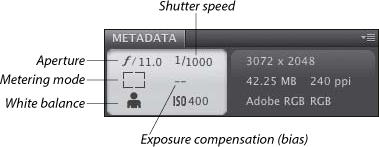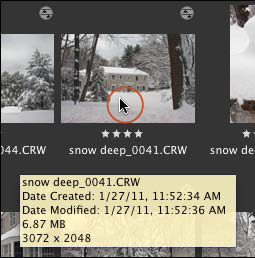3. Bridge

In This Chapter
Downloading photos from a camera
Choosing a workspace for Bridge
Opening files from Bridge into Photoshop
Resetting the Bridge workspaces
Rating and labeling thumbnails
Rearranging and sorting thumbnails
Creating and using collections
The Bridge application ships with Photoshop and is aptly named because it serves as a link to the programs in the Adobe Creative Suite.
You will initially find that Bridge is useful for viewing both thumbnails and large previews of your images before you open them into Camera Raw or Photoshop. Dig a little deeper, and you will find it offers a wealth of other useful features as well.
In Chapter 1, you used Bridge to synchronize the color settings for your Creative Suite programs. Here we show you how to use Bridge to download photos from a digital camera. Following that, you will learn how to preview, examine, label, rate, sort, and filter image thumbnails in the Bridge window; customize the Bridge workspace; organize thumbnails into collections and collapsible stacks; search for, move, copy, and assign keywords to files; and open files into Photoshop. You will also find instructions for using Mini Bridge, a compact version of Bridge that is accessed as a panel in Photoshop, and for exporting the Bridge cache.
Launching Adobe Bridge
When you launch Adobe Bridge, the Bridge window opens.
To launch Adobe Bridge
Do one of the following:
In Windows, click the Start button, choose All Programs, then click Adobe Bridge CS6.
In the Mac OS, double-click the Adobe Bridge CS6 application icon ![]() or click the Bridge icon
or click the Bridge icon ![]() on the Dock.
on the Dock.
In Photoshop, press Ctrl-Alt-O/Cmd-Option-O.
• If you want to have Bridge launch automatically at startup, but without the Bridge window opening onscreen, go to Edit/Adobe Bridge CS6 > Preferences (Ctrl-K/Cmd-K), Advanced panel, and check Start Bridge at Login. This is called “stealth mode.”
Downloading photos from a camera
When you use a digital camera, your photos are stored on a removable memory card — most likely a CompactFlash (CF) or Secure Digital (SD) card. Rather than having to tether your camera directly to a computer, you can remove the memory card and insert it into a card reader device, then download your photos from the card reader to your computer via a USB cable or Firewire cable, depending on which connection your camera supports.
When you start downloading images from a camera, the default application or dialog for acquiring images in your system may launch automatically. Instead of using that application, we recommend using the Photo Downloader application that is included with Bridge, for which instructions are provided here.
To download photos from a card reader via Photo Downloader
1. Take the card out of your camera and insert it into the appropriate slot in the card reader.
2. Plug the card reader into your computer. If the default system application for acquiring photos launches, exit/quit it.
3. Launch Bridge, then click the Get Photos from Camera button ![]() at the top of the Bridge window. The Photo Downloader dialog opens.A If an alert dialog appears and you want to make Photo Downloader the default capture application, click Yes (as we do); if not, click No.
at the top of the Bridge window. The Photo Downloader dialog opens.A If an alert dialog appears and you want to make Photo Downloader the default capture application, click Yes (as we do); if not, click No.

A This is the Standard dialog of the Photo Downloader.
4. From the Get Photos From menu in the Source area, select your card reader.
5. In the Import Settings area, do the following:
To change the save location, click Browse/Choose, then navigate to the desired folder. Click Select Folder/Open to assign that folder and return to the Photo Downloader dialog.
To create a new subfolder within the folder you just selected, choose a naming convention from the Create Subfolder(s) menu, or choose Custom Name and enter a folder name (or choose None for no new subfolder).
Optional: To assign recognizable names and shorter sequential numbers to your digital images in lieu of the long default number, choose a Custom Name option from the Rename Files menu, then enter a name and a starting number. A sample of your entries displays below the field.
Keep Preserve Current Filename in XMP unchecked.
Check Open Adobe Bridge to have the photos display in Bridge when the downloading process is complete.
Also keep Convert to DNG and Delete Original Files unchecked.
To send copies of your photos to a designated folder on an external hard disk (as a backup), check Save Copies To, click Browse/Choose, choose a location, then click Select Folder/Open. This will be your first backup copy.
6. If you want to download select photos (instead of the whole batch) from your memory card, click Advanced Dialog to display the larger Advanced dialog.A Below the thumbnail window, click UnCheck All, then check the box below each photo to be downloaded. Or hold down Ctrl/Cmd and click multiple photos, then check the box for one of them; a check mark will appear below each selected photo.
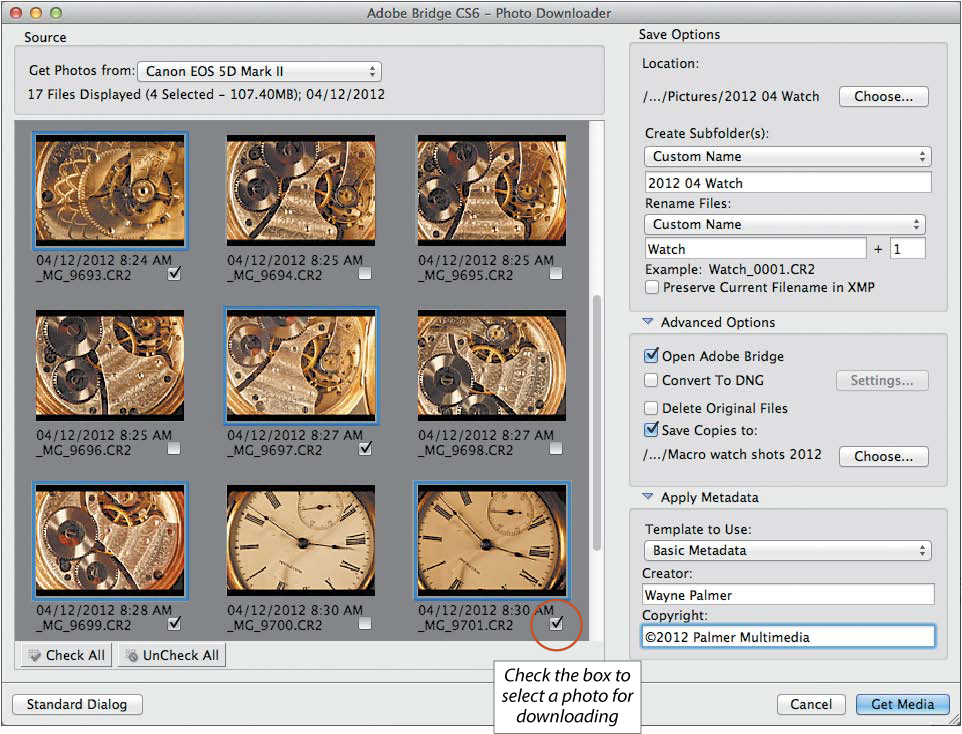
A The Advanced dialog of the Photo Downloader contains the same options as the Standard dialog, plus metadata features and an area for selecting photos to be downloaded.
Optional: In the Apply Metadata area, enter Creator and Copyright info to be added to the metadata of all the downloaded photos. (This metadata will display in Bridge.)
• To switch back to the smaller Standard dialog at any time, click Standard Dialog.
7. Click Get Media to begin the downloading process. When it’s completed, the Photo Downloader dialog is dismissed automatically. If you checked the Open Adobe Bridge option, your photos will display in a new window in Bridge. Don’t worry about previewing or opening them just yet. We’ll step you through that process later.
8. Unmount your card reader.
9. We recommend that you insert a blank DVD and burn the copies of your photo files to the DVD as your second backup copy. In the Mac OS, you can do this via drag-and-drop in the Finder. If you need to learn how to copy files to a DVD, consult the Help files for your operating system.
Features of the Bridge window
We’ll identify the main sections of the Bridge window first, starting from the top (A, next page). The two rows of buttons and menus running across the top of the window are referred to jointly as the toolbar. The second row of the toolbar is also called the Path bar. If the Path bar is hidden, choose Window > Path Bar.


A You’ll learn the function of the Bridge features throughout this chapter.
In the default workspace, Essentials, the main window is divided into three panes: a large pane in the center and a narrower vertical pane on each side. Each pane contains one or more panels, each of which is accessed via its own tab: Favorites, Folders, Filter, Collections, Export, Content, Preview, Metadata, and Keywords. Panels in the side panes let you manage files, preview image thumbnails, filter the display of thumbnails, and display file data; the Content panel in the middle displays file and folder thumbnails. At the bottom of the Bridge window are controls for changing the thumbnail size and display format. (To customize the Bridge window, see pages 28–29 and pages 36–37.)
Next, we’ll briefly describe the Bridge panels that you will learn about in this chapter.
The Favorites panel displays a list of folders that you’ve designated as favorites, for quick and easy access. See page 30.
The Folders panel contains a scrolling window with a hierarchical listing of all the top-level and nested folders on your hard drive(s). See page 30.
The Filter panel lists criteria pertaining to the images in the currently selected folder, such as how many have a specific label, star rating, file type, creation date, or modification date. By clicking various criteria in the Filter panel on or off, you can control which images in the current folder display in the Content panel. To expand or collapse a category, click the arrowhead. See page 41.
The Collections panel displays the names and folder icons of collections, which are thumbnail groups. See pages 46–47.
The Content panel displays thumbnails for images within the currently selected folder (and optionally, thumbnails for nested folders). In the lower-right corner of the Bridge window, you can click a View Content As button to control whether, and in what format, metadata pertaining to the current files displays for each thumbnail in the Content panel (see page 37). For any view type, you can change the thumbnail size (see page 36). The Content panel is used and illustrated in tasks throughout this chapter.
The Preview panel displays a large preview of the image (or folder) thumbnail that is currently selected in the Content panel. Or if the thumbnail for a video or PDF file is selected, controls for playing the video or for viewing the pages display in this panel. Two or more selected image thumbnails can be previewed in this panel, for comparison, and it has a loupe mechanism that you can use to inspect small details of the preview. See pages 30–32.
The Metadata panel has two main sections, both of which display data pertaining to the currently selected thumbnail. The placard at the top contains a quick summary (see the sidebar on page 30), and the main part of the panel lists more detailed data, in collapsible categories. In the File Properties category, for example, you can view the current file name, file size, etc. Via the IPTC Core category, you can attach a copyright notice and other data to a file (see page 39). When the thumbnail for a digital photo is selected, the Camera Data (Exif) category lists the camera settings with which the photo was captured. If the photo was edited in Camera Raw, the panel will also show a Camera Raw category in which the Basic tab settings that are applied to the current photo are listed (to add more Camera Raw specs to this category, go to Edit/Adobe Bridge CS6 > Preferences, Metadata pane, and check boxes under Camera Raw).
Use the Keywords panel to assign one or more descriptive subkeywords to your images, such as an event, subject, client, or location, so they can be located quickly using Bridge features (see pages 38–39). You can do a search to find image thumbnails based on keyword criteria, or narrow the display of thumbnails in the Content panel to specific subcategories of images by checking keywords in the Filter panel.
Note: The Export and Inspector panels aren’t covered in this book (they are designed for file sharing).
Choosing a workspace for Bridge
To reconfigure the Bridge window quickly, choose one of the predefined workspaces. (To create and save custom workspaces, see pages 36–38.)
To choose a workspace for Bridge
Do one of the following:
On the upper toolbar, click Essentials, Filmstrip, Metadata (List View for the thumbnails), Output, Keywords, Preview, Light Table, Folders, or a saved custom workspace.A (If there’s room on the toolbar and you want to display more workspace names, pull the gripper bar to the left.)

From the Workspace menu on the toolbar, choose a workspace B–C (and A–C, next page).

C The Filmstrip workspace features a large preview of the currently selected thumbnail(s).

A In the Essentials workspace, all the panels are showing.

B In the Preview workspace, the thumbnails display in a vertical format (the opposite arrangement from the Filmstrip workspace), and the Metadata and Keywords panels are hidden to make room for a larger preview.

C In the Light Table workspace, the Content panel occupies the entire Bridge window, enabling you to view a large number of thumbnails simultaneously.
Press the shortcut for one of the first six workspaces on the switcher (as listed on the Workspace menu): Ctrl-F1/Cmd-F1 through Ctrl-F6/Cmd-F6. The shortcuts are assigned automatically to the first six workspaces on the switcher, according to their current order from left to right. Not working? These shortcuts may already be used by your operating system, in which case they won’t work in Bridge.
• To change the order of workspaces on the switcher, drag a name to the left or right.
• To learn how to resize the thumbnails in the Content panel, see page 36.
• To create a second Bridge window, choose File > New Window. By default, the new window will display the same contents as the existing one, but you can display a different workspace and folder in each window.
Previewing images in Bridge
To add a folder to the Favorites panel
Do either of the following:
Drag a folder icon from the Content panel or the Explorer/Finder into the Favorites panel (the pointer will be a + symbol).
Right-click a folder in the Folders or Content panel and choose Add to Favorites.
• Via check boxes in the Favorite Items area of Edit/Adobe Bridge CS6 > Preferences > General, you can control which system folders are listed in the Favorites panel.
• To remove a folder from the list of Favorites, right-click it and choose Remove from Favorites.
To display and select images in Bridge
1. Do any of the following:
In the Folders panel, navigate to a folder. You can use the scroll arrows, and you can expand or collapse any folder by clicking its arrowhead.
Display the contents of a folder by clicking its icon in the Folders panel or by double-clicking its thumbnail in the Content panel. Note: For folder thumbnails to display in the Content panel, Show Folders must be checked on the View menu.
Click the Go Back button ![]() on the toolbar A to step back through the last folders viewed, or the Go Forward button
on the toolbar A to step back through the last folders viewed, or the Go Forward button ![]() to reverse your steps.
to reverse your steps.

A These are the navigation controls in Bridge.
Click a folder name in the Favorites panel.
From the Go to Parent or Favorites menu ![]() on the toolbar, choose a parent or Favorites folder.
on the toolbar, choose a parent or Favorites folder.
Click a folder name on the Path bar (Window > Path Bar).
From one of the menus ![]() on the Path bar, choose a folder. If another submenu displays, click yet another folder; repeat until you reach the desired folder.
on the Path bar, choose a folder. If another submenu displays, click yet another folder; repeat until you reach the desired folder.
• To display thumbnails for images in all nested subfolders within the current folder, choose Show Items from Subfolders from the folder menu. ![]() To restore the normal view, click the Cancel button
To restore the normal view, click the Cancel button ![]() on the Path bar.
on the Path bar.
2. In the Content panel do one of the following:
Click an image thumbnail. A colored border appears around it, and data about the file is listed in the Metadata panel. An enlarged preview of the image also displays in the Preview panel, if that panel is showing.
To select multiple, nonconsecutive thumbnails, Ctrl-click/Cmd-click them (A, next page).
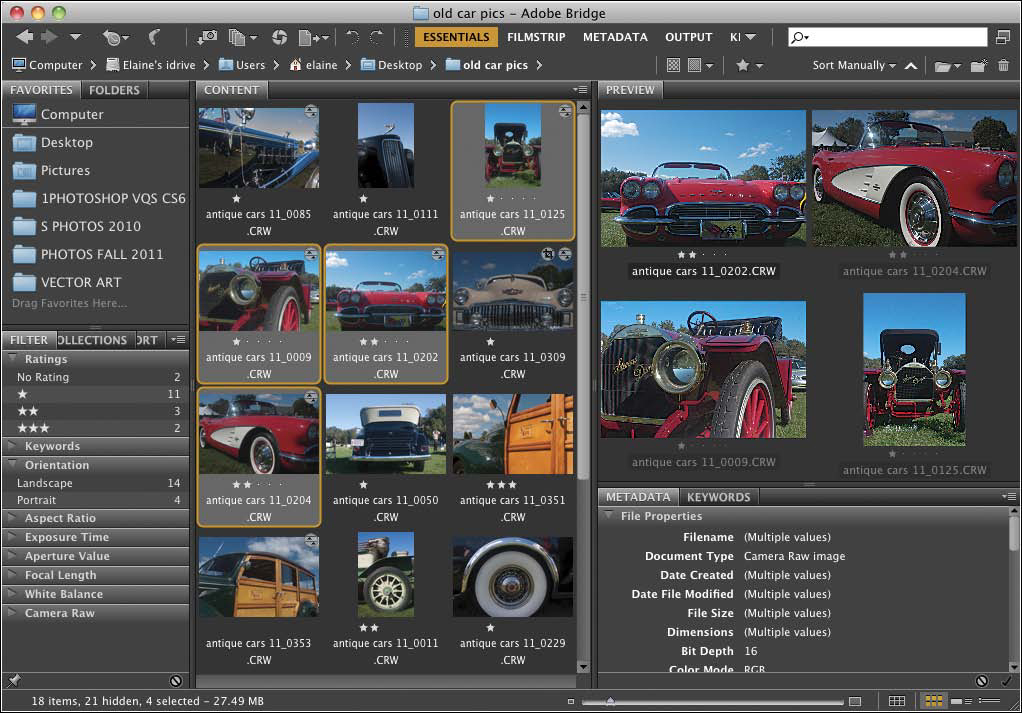
A We held down Ctrl/Cmd and clicked to select multiple image thumbnails.
To select a series of consecutive thumbnails, click the first thumbnail in the series, then Shift-click the last one.
• A number in the upper-left corner of an image thumbnail signifies that it’s part of a stack (group) of thumbnails. To display or hide the contents of a stack, click the stack number (see page 42).
• To cycle through thumbnails in the currently displayed folder, press an arrow key on the keyboard.
• To quickly locate and select a particular thumbnail, start typing the file name without clicking anywhere first.
You can control whether thumbnails and the preview render quickly at low resolution, or more slowly and color-managed at high resolution.
To choose quality options for the Bridge thumbnails and previews
From the Options for Thumbnail Quality and Preview Generation menu ![]() on the Bridge toolbar, choose a preference for the thumbnail quality:
on the Bridge toolbar, choose a preference for the thumbnail quality:
Prefer Embedded (Faster) displays low-resolution thumbnails and is useful for displaying a high volume of images quickly.
High Quality on Demand displays high-resolution, color-managed thumbnails and previews (which are generated from the source files) for selected thumbnails and low-resolution previews for unselected thumbnails. This is a good compromise between the two other options.
Always High Quality, the default setting, displays high-resolution thumbnails and previews, whether the thumbnails are selected or not. Rendering is the slowest with this option.
• To quickly access lower-quality, faster previewing, click the Browse Quickly by Preferring Embedded Images ![]() button on the Bridge Path bar; this enables the Prefer Embedded (Faster) option. Click the button again to return to the current setting on the Options for Thumbnail Quality and Preview Generation menu.
button on the Bridge Path bar; this enables the Prefer Embedded (Faster) option. Click the button again to return to the current setting on the Options for Thumbnail Quality and Preview Generation menu.
• The Generate 100% Previews option on the Options for Thumbnail Quality and Preview Generation menu saves actual-size JPEG versions of thumbnails, which in turn enables Bridge to generate higher-quality previews when the loupe is used or when images are displayed at 100% size in Full Screen Preview or Slideshow view. This option utilizes a lot of disk space, so we recommend keeping it unchecked.
To compare two or more image previews
1. In Bridge, click or choose the Filmstrip or Preview workspace.
2. In the Content panel, Ctrl-click/Cmd-click up to nine thumbnails (the maximum number that can be previewed at a time).A Large versions of the thumbnails will display in the Preview panel.

A We Ctrl/Cmd-clicked two image thumbnails to display them in the Preview panel, then clicked a preview to display the loupe.
3. Optional: Ctrl-click/Cmd-click an unselected thumbnail in the Content panel to add it to the Preview panel, or do the same for a selected thumbnail to remove it from the Preview panel.
To display a full-screen preview of an image thumbnail
1. Press the Spacebar to display a full-screen preview of the currently selected thumbnail and hide the Bridge window temporarily.
2. To zoom in or out, press + or – or use the scroll wheel on your mouse (you can drag the magnified preview). If desired, press the left or right arrow key to cycle through other thumbnails in the same folder.
3. To redisplay the Bridge window, press the Spacebar or Esc.
To inspect image details via an onscreen loupe
1. To make the loupe appear, click an image in the Preview panel B or click the frontmost image in Review mode (see the next page).
Note: If the loupe doesn’t appear, it’s because the Ctrl-Click/Cmd-Click Opens the Loupe When Previewing or Reviewing option is checked in Edit/Adobe Bridge CS6 > Preferences > General. Ctrl-click/Cmd-click the image to make the loupe appear.
2. Click the area to be examined. To zoom in on the loupe display (up to 800%), press + or use the scroll wheel on your mouse; to zoom out, press –.
3. To examine a different area, click that area or drag the loupe to it.
4. Optional: If you’re previewing two images using two loupes, you can Ctrl-drag/Cmd-drag either loupe to move them simultaneously.
5. To remove the loupe, click inside it.
You can put selected thumbnails into Review mode, in which the thumbnails display as large previews on a black background and the Bridge window is hidden, then cycle through the images as if they’re on a carousel. You can also rate thumbnails in this mode.
To preview images in Review mode
1. Do one of the following:
Open a folder of images.
Hold down Alt/Option and click a thumbnail stack (see page 42).
Select five or more image thumbnails (Ctrl/Cmd or Shift-click them).
2. Press Ctrl-B/Cmd-B, or from the Refine menu ![]() at the top of the Bridge window, choose Review Mode. The Bridge window is hidden temporarily, and the images display on a black background.
at the top of the Bridge window, choose Review Mode. The Bridge window is hidden temporarily, and the images display on a black background.
3. To rotate the carousel, do any of the following:
Drag any image preview to the left or right.
Click one of the smaller previews to bring it to the forefront.
Click (and keep clicking) the Go Forward ![]() or Go Backward
or Go Backward ![]() button in the lower-left corner, or press the left or right arrow key.
button in the lower-left corner, or press the left or right arrow key.
4. To examine the frontmost (enlarged) image with a loupe, click it. Drag the loupe to move it. Click the loupe again to remove it.
5. To rate or label the frontmost thumbnail, right-click it and choose a star rating or a label from the context menu A or press Ctrl/Cmd plus a numeral between 1 and 9. (To view a list of shortcuts, press H.)

A We held down Ctrl/Cmd and clicked nine image thumbnails, pressed Ctrl-B/Cmd-B to view them in Review mode, then right-clicked the frontmost thumbnail and are choosing a star rating from the context menu.
6. To take the frontmost image out of the carousel, click the down-pointing arrow ![]() in the lower-left corner, or drag the image to the bottom of your screen. (This won’t delete the actual file.)
in the lower-left corner, or drag the image to the bottom of your screen. (This won’t delete the actual file.)
• You can use this method to pare down a selection of images before grouping them as a stack (see pages 42–43) or as a collection (see pages 46–47).
7. To exit Review mode, press Esc or click the ![]() in the lower-right corner.
in the lower-right corner.
8. Click any image thumbnail to deselect the rest.
Opening files from Bridge into Photoshop
You can open as many files into Photoshop as the currently available RAM and scratch disk space on your computer allow.
Note: To open a raw, JPEG, or TIFF digital photo into Camera Raw (so you can apply corrections to it before opening it into Photoshop), see page 55. To open a file from Mini Bridge into Photoshop, see page 49.
To open files from Bridge into Photoshop
1. In the Content panel, display the thumbnail for the image(s) to be opened.
2. Do either of the following:
Double-click an image thumbnail.
Click an image thumbnail or select multiple thumbnails, then double-click one of them or press Ctrl-O/Cmd-O.
3. Photoshop will launch, if it isn’t already running, and the image(s) will appear onscreen. If any alert dialogs appear, see the next page.
• If a photo has been opened in Camera Raw and settings were applied to it in that dialog, it will have an icon ![]() in the top right corner of the thumbnail. If you want to open such a file (or a raw photo) directly into Photoshop (bypassing Camera Raw), Shift-double-click it.
in the top right corner of the thumbnail. If you want to open such a file (or a raw photo) directly into Photoshop (bypassing Camera Raw), Shift-double-click it.
• To locate an “actual” file in Explorer/Finder, right-click its thumbnail in Bridge and choose Reveal in Explorer/Reveal in Finder from the context menu. The folder that the file resides in will open in a window in Explorer/Finder and the file icon will be selected.
• By default, the Bridge window stays open after you use it to open a file. To minimize the Bridge window as you open a file, hold down Alt/Option while double-clicking the file thumbnail.
• To open an image from Review mode in Bridge into Photoshop, right-click it and choose Open from the context menu.
To reopen a recently opened file
To reopen a file that was recently opened and then closed, choose the file name in one of these locations:
In Bridge, choose from the Open Recent File menu ![]() on the right side of the Path bar.
on the right side of the Path bar.
In Bridge or Photoshop, choose from the File > Open Recent submenu.
In Bridge, from the Reveal Recent File or Go to Recent Folder menu, ![]() choose Adobe Photoshop > Recent Adobe Photoshop Files. Thumbnails for the recently open files will display in the Content panel. Double-click a thumbnail to open that file. To redisplay the last displayed folder when you return to Bridge, click the Go Back arrow
choose Adobe Photoshop > Recent Adobe Photoshop Files. Thumbnails for the recently open files will display in the Content panel. Double-click a thumbnail to open that file. To redisplay the last displayed folder when you return to Bridge, click the Go Back arrow ![]() or a Favorites folder.
or a Favorites folder.
In Photoshop, display the Mini Bridge panel (Window > Extensions > Mini Bridge). From the menu in the Navigation pod, choose Recent Files, then click Photoshop. Double-click a thumbnail to open that file. See pages 48–49.
To respond to alert dialogs upon opening a file into Photoshop
• If you open a file in Photoshop in which a missing font is being used (the font isn’t available or installed), an alert dialog will appear.A If you click OK to open the file, the Font Missing on System alert icon will display on the offending layer(s) on the Layers panel. If you try to edit the layer, yet another alert dialog will appear, indicating that font substitution will occur if you click OK.B You can either click OK to allow the missing font to be replaced or click Cancel, make the required fonts available, then reopen the document.

A This alert dialog appears if fonts that are being used in the file you’re opening are missing.
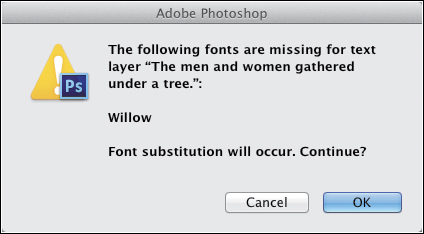
B This alert dialog appears if you try to edit an editable type layer that’s using a missing font.
Note: If you want to replace all missing fonts with different (available) fonts, choose Type > Replace All Missing Fonts.
• If the file’s color profile doesn’t match the current working space for Photoshop, the Embedded Profile Mismatch alert dialog will appear.C Click Use the Embedded Profile (Instead of the Working Space) if you must keep the document’s current profile. Or for consistency with our color management workflow, click Convert Document’s Colors to the Working Space to convert the profile to the current working space. Click OK. See also pages 8, 10, and 12.

C If this Embedded Profile Mismatch alert dialog appears, indicate whether you want to continue to use the embedded profile or convert the file to the current working space.
• If the Missing Profile alert dialog appears,D click Assign Working RGB: Adobe RGB (1998) to assign the profile that you chose as the working space for Photoshop (see pages 8 and 12).
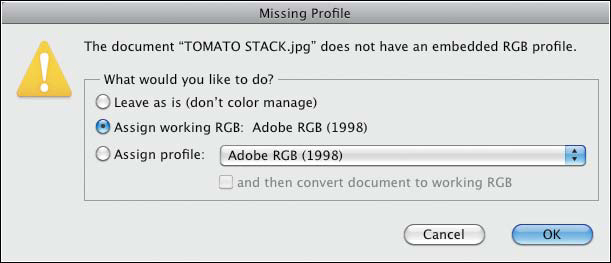
D If this Missing Profile alert dialog appears, click Assign Working RGB: Adobe RGB (1998) to convert the file to the default working space for Photoshop.
Customizing the Bridge window
To display or hide individual panels
On the Window menu, check the panels you want to show and uncheck the ones you want to hide.
• To quickly hide (and then show) the side panes, press Tab or double-click the dark vertical bar between a side pane and the middle pane.
• To display just the Content panel in a compact window, click the Switch to Compact Mode button ![]() in the upper-right corner of the Bridge window. Click the button again to restore Full Mode (the former window size).
in the upper-right corner of the Bridge window. Click the button again to restore Full Mode (the former window size).
To configure the Bridge panes and panels manually
Do any of the following:
To make a panel or panel group taller or shorter, drag its horizontal gripper bar upward or downward.A

A We’re dragging the horizontal bar upward to shorten the Favorites/Folders panel group and lengthen the Filter/Collections/Export panel group.
To make a whole pane wider or narrower, drag its vertical gripper bar horizontally;B the adjacent pane resizes accordingly.

To minimize a panel or panel group to just a tab (or to restore its former size), double-click its tab.
To move a panel into a different group, drag the panel tab, and release the mouse when the blue drop zone border appears around the desired group.
To display a panel as a separate group, drag its tab upward or downward between two panels, and release the mouse when the horizontal blue drop zone line appears.
To resize the image thumbnails
At the bottom of the Bridge window, drag the Thumbnail Size slider.C You could also click the button located to the left or right of the slider to restore the last Smaller Thumbnail Size or last Larger Thumbnail Size, respectively.
• To display only full thumbnails, with grid lines between them, click the Lock Thumbnail Grid button ![]() at the bottom of the Bridge window. With this option on, no shuffling of thumbnails will occur if you resize the Content panel.
at the bottom of the Bridge window. With this option on, no shuffling of thumbnails will occur if you resize the Content panel.
To control how metadata is displayed in the Content panel
1. In the lower-right corner of the Bridge window, click one of these View Content buttons: A

A These buttons control the display of metadata in the Content panel.
View Content as Thumbnails (minimal file data), View Content as Details (more file data),B or View Content as List (small icons with columns of data).

B With the View Content as Details button clicked, metadata displays next to the file thumbnails.
2. To control which categories of metadata display below or next to the image thumbnails when the View Content as Thumbnails option is chosen, go to Edit/Adobe Bridge CS6 > Preferences > Thumbnails, then select from any or all of the Details: Show menus. For example, to display exposure settings, you would choose Exposure.
• With View Content as List chosen, you can change the column order by dragging any column header to the left or right. You can also right-click any column header to access options for changing the column data, inserting and closing columns, and changing the column width.
• When the View Content as Thumbnails option is chosen for Bridge, you can toggle the display of metadata on and off by pressing Ctrl-T/Cmd-T. When viewing thumbnails in the Light Table workspace, we prefer to keep the metadata hidden.
Saving custom workspaces
If you save your customized workspaces, you’ll be able to access them again quickly at any time and will avoid having to reconfigure the Bridge window at the beginning of your work sessions.
To save a custom workspace for Bridge
1. Do all of the following:
Choose a size and location for the overall Bridge window.
Arrange the panel sizes and groups as desired.
Choose a thumbnail size for the Content panel.
Choose a sorting order for thumbnails from the Sort menu at the top of the Bridge window (see page 41).
Click a View Content button (see the previous page).
2. From the Workspace menu on the workspace switcher, choose New Workspace.
3. In the New Workspace dialog,A enter a Name for the workspace, check Save Window Location as Part of Workspace and/or Save Sort Order as Part of Workspace (both are optional), then click Save.
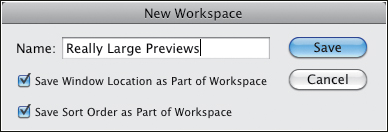
A Use the New Workspace dialog to name your custom workspace and choose options for it.
Note: Your new workspace will be listed first on the switcher and will be assigned the first shortcut (Ctrl-F1/Cmd-F1). To change the order of workspaces on the switcher, drag any workspace name horizontally to a different slot. When you do this, the shortcuts will be reassigned based on the new order.
• To delete a user-saved workspace, from the Workspace menu, choose Delete Workspace. From the menu in the dialog, choose the workspace to be deleted, then click Delete.
• To choose colors for the Bridge interface (including the background shade behind the panels and image previews, and the highlight border around selected thumbnails), see page 444.
Resetting the Bridge workspaces
If you make a manual change to a saved workspace, the change will stick with the workspace even if you switch to a different one (or exit/quit and relaunch Bridge). For instance, if you were to change the thumbnail size for the Filmstrip workspace, switch to the Essentials workspace, then switch back to Filmstrip, you would see your new thumbnail size again. This is a good thing. On the occasion that you want a fresh start, however, there are commands for restoring the default settings to any individual predefined (standard Adobe) or user-saved workspace, or to all the predefined workspaces at once.
To reset the Bridge workspace
Do either of the following:
To restore the default settings to one workspace, right-click the workspace name on the switcher and choose Reset.
To restore the default settings to all the Adobe predefined workspaces, choose Reset Standard Workspaces from the Workspace menu.
Assigning keywords to files
Keywords (words that are assigned to files) are used by operating system search utilities to locate files and by file management programs to organize them. In Bridge, you can create parent keyword categories (for events, places, themes, clients, etc.), and nested subkeywords within those categories, and then assign them to your files. You can locate files by entering keywords as search criteria in the Find dialog, build a Smart Collection based on a search for keywords (see page 46), and display files by checking Keywords criteria in the Filter panel (see page 41).
To create keywords and subkeywords in the Keywords panel
1. Display the Keywords panel. To create a new parent keyword category, click the New Keyword button, ![]() type a keyword, then press Enter/Return.
type a keyword, then press Enter/Return.
2. To create a nested subkeyword, click a parent keyword, click the New Sub Keyword button, ![]() type a word, then press Enter/Return (A, next page). Each time you want to add a subkeyword, click the parent keyword first. You can also create nested sub-subkeywords.
type a word, then press Enter/Return (A, next page). Each time you want to add a subkeyword, click the parent keyword first. You can also create nested sub-subkeywords.
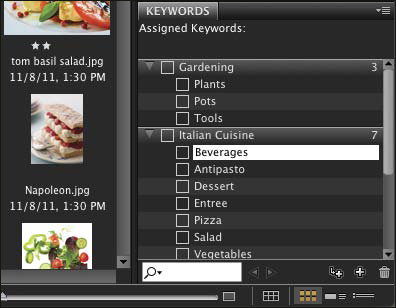
A We created a new parent keyword entitled “Italian Cuisine,” then added some subkeywords to it via the New Sub Keyword button.
• You can move (drag) any subkeyword from one parent keyword category into another.
To assign keywords to files via the Keywords panel
1. Select one or more image thumbnails in the Content panel. If keywords are already assigned to any of those files, they will be listed at the top of the Keywords panel (you can assign more).
2. Check the box for one or more subkeywords.B You can assign just subkeywords to a file (as we do) or assign parent keywords and subkeywords. To remove a keyword from a file, uncheck the box.

B We clicked an image thumbnail, then assigned relevant subkeywords to it by checking boxes.
• Read about the Keywords Preferences on page 446.
• If you select the thumbnail for a file to which keywords were assigned outside of Bridge (e.g., in Photoshop via File > File Info), those keywords will display temporarily in the Keywords panel, under Other Keywords. To convert a keyword to a permanent subkeyword, right-click it and choose Make Persistent from the context menu.
To assign keywords to files via the Metadata panel
1. Select one or more image thumbnails in the Content panel.
2. Display the Metadata panel, and expand the IPTC Core category.
3. Click the Keywords listing, then enter keywords, separated by semicolons or commas.C Be on the alert for typing errors!

C We’re assigning keywords to a file via the Metadata panel.
4. Click the Apply button ![]() in the lower-right corner of the panel.
in the lower-right corner of the panel.
• You can also use the IPTC Core category in the Metadata panel to assign other data to a file, such as a copyright notice. Use the same method as in the steps above (you can press Tab to proceed from one field to the next).
Rating and labeling thumbnails
If you assign each thumbnail a star rating and/or color label, you’ll be able to sort them in the Content panel based on their ranking, control which ones display via the Filter panel, and locate them easily via the Find command. In addition, you can apply a Reject rating to any image thumbnails that you want to hide from the Content panel but aren’t ready to delete from your hard drive.
To rate and label thumbnails
1. Select either View Content as Thumbnails or View Content as Details as the view option for thumbnails (see page 37). Select one or more image thumbnails in the Content panel.
2. Do any of the following:
From the Label menu, choose a Rating (to assign a star ranking) and/or a Label (to add a color-coded strip below the thumbnail).A

A This thumbnail has an Approved (green) rating.
Click a thumbnail, then click any one of the five dots below it; stars will appear.B To remove one star, click the star to its left. To remove all the stars from a thumbnail, click to the left of the first one.C (If you don’t see the dots or stars, enlarge the thumbnails via the Thumbnail Size slider.)

B We clicked the third dot on this thumbnail to give it a three-star rating...

C ...but then we changed our minds, so we clicked to the left of the stars to remove them.
Press one of the keyboard shortcuts that are listed on the Label menu, such as Ctrl/Cmd plus a number (e.g., Ctrl-2/Cmd-2 for two stars, or Ctrl-8/Cmd-8 for Approved).
Right-click a thumbnail in the Content panel, then choose a category from the Label submenu from the context menu.
Right-click in the Preview panel and choose a star rating and/or label from the context menu.
To label the losers with a red “Reject” label, choose Label > Reject or press Alt-Del/Option-Delete.D Via the Show Reject Files option on the View menu, you can show or hide all rejected thumbnails.

D We gave this poor fellow a Reject rating (Alt-Del/Option-Delete).
• You can assign custom names to labels in Edit/Adobe Bridge CS6 > Preferences > Labels.
To remove ratings or labels from thumbnails
1. Select one or more image thumbnails.
2. To remove stars, choose No Rating from the Label menu or press Ctrl-0/Cmd-0 (zero). To remove a label, choose No Label from the Label menu or press the shortcut for the currently assigned label.
Rearranging and sorting thumbnails
To rearrange thumbnails manually
Drag a thumbnail to a new location; or Ctrl-click/Cmd-click multiple thumbnails, then drag one of the selected thumbnails. The listing on the Sort menu on the Path bar changes to “Sort Manually.”
The current criterion on the Sort menu controls the order in which thumbnails display in the Content panel. After applying ratings to our thumbnails, we choose By Rating from the Sort menu to display them by rating, in ascending order. The sorting order also affects the batch and automate commands in Bridge, because those commands process files based on the current sequence of thumbnails.
To choose a sorting order for thumbnails
From the Sort menu on the Path bar, choose a sorting criterion (such as By Rating).A All thumbnails that are currently displaying in the Content panel will be re-sorted. Note: If you display a different folder, the current sorting order will apply.
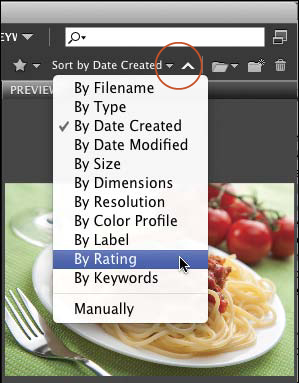
A From the Sort menu on the Path bar, choose a sorting order for your selected thumbnails.
• To restore the last sequence of thumbnails that was created by dragging them manually, choose Manually from the Sort menu.
• To reverse the current order, click the Ascending Order ![]() or Descending Order
or Descending Order ![]() arrowhead.
arrowhead.
Filtering thumbnails
The categories and listings on the Filter panel (e.g., Ratings, Keywords, Date Created) change dynamically depending on the data contained in the currently displayed folder of thumbnails, and also on what categories are checked on the panel menu. When you check the boxes for specific criteria in the panel, only the thumbnails that meet those criteria will display in the Content panel. Note: Filtering doesn’t affect thumbnails in stacks.
To filter the display of thumbnails
Do either of the following:
On the Filter panel, click the arrowhead to expand any category, such as Labels, Ratings, or Keywords, then check one or more criteria.B For example, to display only files that have an Approved label and a rating of three stars, check Approved under Labels and check the three-star listing under Ratings. To remove a criterion, click the listing again.

B Because we checked the three-star ranking in the Filter panel (Ratings category), only thumbnails that have three stars will display in the Content panel.
From the Filter Items by Rating menu ![]() on the Bridge toolbar,C check the desired criteria.
on the Bridge toolbar,C check the desired criteria.

C Via the Filter Items by Rating menu, you can filter thumbnails based on their ratings.
• To prevent the current filters (those with check marks) from clearing when you display other folders, activate the Keep Filter When Browsing ![]() button on the panel; when activated, the button displays in color.
button on the panel; when activated, the button displays in color.
• To remove all check marks from the Filter panel, click the Clear Filter ![]() button at the bottom of the panel or press Ctrl-Alt-A/Cmd-Option-A.
button at the bottom of the panel or press Ctrl-Alt-A/Cmd-Option-A.
Using thumbnail stacks
One way to reduce the number of thumbnails that display at a given time is to group them into expandable stacks. You can organize your stacks based on categories, such as landscapes, portraits, or shots taken with a particular camera setting. Unlike collections (see pages 46–47), stacks can’t be labeled.
To group thumbnails into a stack
1. Shift-click or Ctrl-click/Cmd-click to select two or more file thumbnails.A The thumbnail that is listed first in your selection will become the “stack thumbnail” (will display on top of the stack).
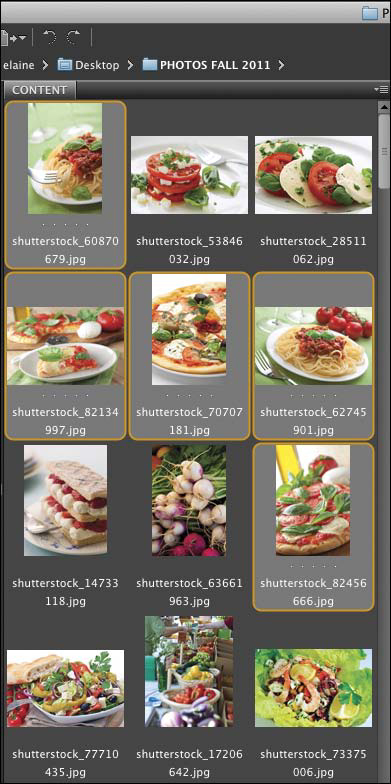
A We selected several thumbnails for grouping in a stack.
2. Press Ctrl-G/Cmd-G or right-click one of the selected thumbnails and choose Stack > Group as Stack.B A stack looks like a couple of playing cards in a pile, with the stack thumbnail on top. The number in the upper-left corner (the “stack number”) indicates how many thumbnails the stack contains.

B Next, we chose the Group as Stack command.
To select the thumbnails in a stack
To both select and display all the thumbnails in a stack, click the stack number (click it again to collapse the stack). The stack will remain selected.
To select all the thumbnails in a stack while keeping the stack collapsed, click the stack border (the bottom “card”) or Alt-click/Option-click the stack thumbnail (the top image in the stack). Note that although the stack is collapsed, because it is selected, all the thumbnails it contains will display in the Preview panel, if that panel is showing.
• Provided your thumbnails aren’t too small, a slider will display on a bar next to the stack number of a closed stack. You can drag the slider to quickly preview the thumbnails.
To rearrange thumbnails within a stack
To move a thumbnail to a different position in an expanded stack, click it to deselect the other selected thumbnails, then drag it to a new spot (as shown by the vertical drop zone line).
To move a whole stack to a different position
1. Collapse the stack, then Alt-click/Option-click the stack thumbnail. The borders of both “cards” in the stack should now be highlighted.
2. Drag the stack thumbnail (not the border).
• If you drag the top thumbnail of an unselected stack, you’ll move just that thumbnail, not the whole stack.
To add a thumbnail to a stack
Drag a thumbnail over a stack thumbnail or into the desired position in an open stack.
To remove a thumbnail from a stack
1. Click the stack number to expand the stack.
2. Click the thumbnail to be removed, then drag it out of the stack.
To ungroup a stack
1. If the stack is collapsed, click the stack thumbnail; if the stack is expanded, click the stack number.
2. Press Control-Shift-G/Cmd-Shift-G (Stacks > Ungroup from Stack) or right-click the stack and choose Stack > Ungroup from Stack. The stack number and border disappear.
Managing files using Bridge
To create a new folder
1. Via the Folders panel or the Path bar, navigate to the folder to which you want to add a folder.
2. Click the New Folder button ![]() at the right end of the Bridge toolbar. Type a name to replace the highlighted one, then press Enter/Return.
at the right end of the Bridge toolbar. Type a name to replace the highlighted one, then press Enter/Return.
You can move files to a different folder on your hard disk either by dragging the thumbnails manually or via a command.
To move or copy files between folders
Method 1 (by dragging)
1. Select one or more thumbnails (Content panel).
2. In the Folders panel, navigate to (but don’t click) the folder or subfolder into which you want to move the selected files.
3. To move the selected files, drag them over the folder name in the Folders panel (then release), or to copy them, do the same except hold down Ctrl/Option while dragging (a + symbol will appear in the pointer). Note: If you want to move files to another hard disk, hold down Shift/Cmd while dragging.
Method 2 (via the context menu)
1. Select one or more thumbnails in the Content panel.
2. Right-click one of the selected thumbnails, then from the Move To or Copy To submenu on the context menu, do either of the following:
Select a folder name under Recent Folders or Favorites.
Select Choose Folder. Locate a folder in the Open dialog, then click Open.
• To copy files via the Clipboard, select one or more thumbnails, press Ctrl-C/Cmd-C to copy them, click the desired folder, then press Ctrl-V/Cmd-V to paste.
To delete a file or folder
1. Click an image or folder thumbnail or Ctrl-click/Cmd-click multiple thumbnails, or Shift-click a series of them.
2. Do either of the following:
Press Ctrl-Backspace/Cmd-Delete, then if an alert dialog appears, click OK.
Press Del/Delete on your extended keyboard, then if an alert dialog appears, click Delete.
• Oops! Change your mind? To retrieve a deleted file or folder, choose Edit > Undo immediately. Or to dig it out of the trash, double-click the Recycle Bin/Trash icon for your operating system, then drag the item into the Content panel in Bridge. Phew.
To rename a file or folder
1. Click a thumbnail, then click the file or folder name. The name becomes highlighted.A

A To rename a file, click the existing file name...
2. Type a new name B (for an image file, don’t try to delete the extension), then either press Enter/Return or click outside the name field.
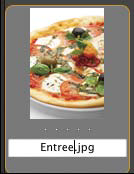
B ...then type a new one.
When you download digital photos from your camera to your computer, they keep the sequential numerical labels (e.g., “CRW_3816”) that your camera assigned to them. Via the Batch Rename command in Bridge, you can assign more recognizable names to your photos, to make them easier to identify.
To batch-rename files
1. Display the contents of the folder that contains the files to be renamed, then select the thumbnails for the files to be renamed.
2. Do either of the following:
Choose Tools > Batch Rename (Ctrl-Shift-R/Cmd-Shift-R).
From the Refine menu ![]() at the top of the Bridge toolbar, choose Batch Rename. The Batch Rename dialog opens.A
at the top of the Bridge toolbar, choose Batch Rename. The Batch Rename dialog opens.A
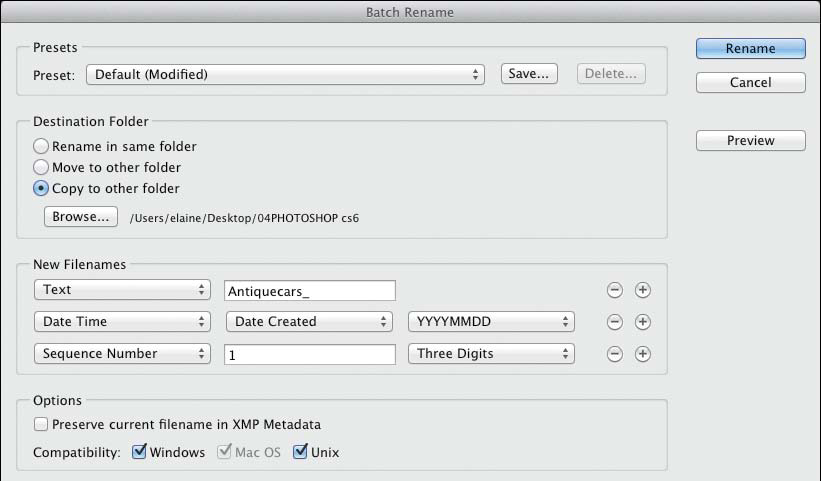
A Via the Batch Rename dialog, you can quickly rename an entire folder full of photos.
3. From the Preset menu, choose Default.
4. Under Destination Folder, click one of the following:
Rename in Same Folder to rename the files and leave them in their current location.
Move to Other Folder to rename the files and move them to a new location.
Copy to Other Folder to leave the original files unchanged but rename the copies and move them to a new location (this is a quick way to duplicate a batch of photos). We recommend using this option, especially if you didn’t elect to copy your photos when you downloaded them.
For the Move or Copy option, also click Browse, choose or create a new folder, then click Open.
5. In the New Filenames area, specify data to be included in the names: Text (enter the desired name); Date Time (choose options from both menus); and Sequence Number to include an incremental number in the names (enter a starting number and choose a digit option).
To add another row of criteria fields, click the ![]() button, or to remove a row of fields, click the
button, or to remove a row of fields, click the ![]() button.
button.
Click Preview to view a listing of the new file names, then click OK to exit that dialog.
6. Under Options, leave Preserve Current Filename in XMP Metadata unchecked (unless you need to preserve the old names), but for Compatibility, check any other operating system in which you want your renamed files to be readable.
7. Optional: To save the current New Filenames and Options settings as a preset for future use, click Save, enter a name, then click OK. Your custom preset will appear on the Preset menu.
8. To apply your naming choices to the selected thumbnails, click Rename.
Searching for files
To find files via Bridge
1. In Bridge, choose Edit > Find (Ctrl-F/Cmd-F). The Find dialog opens.A

A We entered three criteria in the Find dialog (then we clicked Find).
2. From the Look In menu in the Source area, choose the folder to be searched (by default, the current folder is listed). To select a folder that isn’t listed on the menu, choose Look In: Browse, locate the desired folder, then click Open.
3. From the menus in the Criteria area, choose search criteria (e.g., Filename, Date Created, Keywords, Label, Rating, or camera settings), choose a parameter from the adjoining menu, and enter data in the field. To add another criterion to the search, click the ![]() button, or to remove a row of fields, click
button, or to remove a row of fields, click ![]() .
.
4. From the Match menu, choose “If any criteria are met” to find files based on one or more of the criteria you have specified, or choose “If all criteria are met” to narrow the selection to just the files that meet all your criteria.
5. Check Include All Subfolders to include, in the search, any of the subfolders that are inside the folder you chose in step 2.
6. Optional: Check Include Non-Indexed Files to search through files that Bridge hasn’t yet indexed (any folder Bridge has yet to display). As indicated, this could slow down the search.
7. Click Find. The results of the search will be placed in a temporary folder called Search Results: [name of source folder] and will display in the Content panel.B The folder will be listed on the Path bar and on the Reveal Recent File or Go to Recent Folder menu ![]() on the Bridge toolbar.
on the Bridge toolbar.

B The results from our search appeared in the Content panel. The parameters used for the search and the folder that was searched are listed next to “Find Criteria.”
8. To create a collection from the results of the search, see the following page.
• To discard the current search results and start a new search, click New Search, or to cancel the results, click the Cancel button. ![]()
Creating and using collections
Using the collection features in Bridge, you can catalog your file thumbnails without having to relocate the actual files. There are two kinds of collections: a Smart Collection that you create from the results of a Find search, and what we call a “nonsmart” collection, which is created by dragging thumbnails manually.
To create a Smart Collection
1. Click the tab for the Collections panel. (If it’s hidden, choose Window > Collections Panel.)
2. Perform a search via the Edit > Find command (see the preceding page). When the search is completed, click the Save as Smart Collection button ![]() at the top of the Content panel.A
at the top of the Content panel.A

A To create a Smart Collection, use the Find command, then click the Save as Smart Collection button in the Content panel.
3. A new Smart Collection icon ![]() appears in the Collections panel. Type a name in the highlighted field, then press Enter/Return.B
appears in the Collections panel. Type a name in the highlighted field, then press Enter/Return.B

B A new Smart Collection appears on the Collections panel. Type a name for it in the field.
• To add a collection to the Favorites panel, right-click the icon and choose Add to Favorites.
• To delete a collection, click it, click the Delete Collection button, ![]() then click Yes if an alert dialog appears (this won’t delete the actual files).
then click Yes if an alert dialog appears (this won’t delete the actual files).
To display the contents of a collection
In the Collections panel, click the icon or name of a Smart Collection. ![]()
If you run a new search for an existing Smart Collection based on new criteria, the contents of the collection will update automatically.
To edit a Smart Collection
1. In the Collections panel, click the icon for an existing Smart Collection. ![]()
2. At the top of the Content panel or in the lower-left corner of the Collections panel, click the Edit Smart Collection button. ![]() C
C

C To edit a Smart Collection, click its icon in the Collections panel, then click the Edit Smart Collection button.
3. The Edit Smart Collection dialog opens. It looks just like the Find dialog, which is shown on the preceding page. To add another criterion, click the next ![]() button, choose and enter data, and choose “If any criteria are met” from the Match menu. You can also change the source folder and/or change or eliminate the original criteria.
button, choose and enter data, and choose “If any criteria are met” from the Match menu. You can also change the source folder and/or change or eliminate the original criteria.
4. Click Save. The results of the new search will display in the Content panel.
Note: If you move a thumbnail from a Smart Collection (or move the actual file) into a folder that wasn’t used in the search, it will be removed from the collection, but not from your hard disk. If you delete a thumbnail from a Smart Collection, on the other hand — watch out! — the actual file will be deleted from your hard disk!
You can also create a collection without running a search first. We call this a “nonsmart” collection.
To create a nonsmart collection
1. Do either of the following:
On the Content panel, select the image thumbnails to be put into a collection. In the Collections panel, click the New Collection button, ![]() then click Yes in the alert dialog.
then click Yes in the alert dialog.
While viewing some thumbnails in Review mode (Ctrl-B/Cmd-B), drag any files you don’t want to include in the collection out of the carousel, then click the New Collection button. ![]()
2. Type a name in the highlighted field in the Collection panel.A The number of thumbnails the collection contains is listed next to the name.

A To create a nonsmart collection, click the New Collection button, then type a name for it.
To add thumbnails to a nonsmart collection
1. Display the Collections panel.
2. Drag one or more thumbnails from the Content panel over a nonsmart collection icon. ![]() B
B

B Drag thumbnails to a nonsmart collection listing.
• You can copy and paste thumbnails from a Smart Collection into a nonsmart one, or from one nonsmart collection into another. You can’t drag thumbnails into a Smart Collection.
To remove thumbnails from a nonsmart collection
1. On the Collections panel, click the icon for a nonsmart collection ![]() to display its contents.
to display its contents.
2. Select the thumbnails to be removed, then click Remove from Collection at the top of the Content panel.C
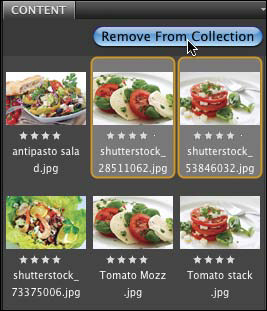
C To remove selected thumbnails from the currently displayed collection, click Remove from Collection.
If you rename a file in Explorer/Finder or move a file from its original location on disk, it may be listed as missing from any nonsmart collections it is a part of, and Bridge will try to relink it to those collections. If Bridge is unsuccessful, do as follows.
To relink a missing file to a nonsmart collection
1. On the Collections panel, click the collection to which you need to relink one or more files.
2. At the top of the Content panel, click Fix.D

D To relink a file that’s missing from a collection, click Fix.
3. In the Find Missing Files dialog, click Browse, click the missing file (the name is listed at the top of the dialog), click Open, then click OK.
Using Mini Bridge
Mini Bridge is a compact version of Bridge that you access as a panel in Photoshop. What is called a panel in Bridge is known as a pod in Mini Bridge. The interface has changed significantly from version CS5 (menus were moved, the ability to enlarge one preview in the panel was eliminated for some unfortunate reason, etc.) and takes some getting used to.
To preview files in Mini Bridge 
1. Go to Photoshop. If the Mini Bridge panel is hidden, choose either Window > Extensions > Mini Bridge or File > Browse in Mini Bridge to display it (A, next page).

A The Mini Bridge panel in Photoshop offers many of the same features as Adobe Bridge, except in a more compact, convenient size.
• If you widen the Mini Bridge panel (drag an edge), the thumbnails will display on the right side; if you narrow it, the thumbnails will display below the Navigation pod.
2. If Bridge isn’t running, a “Bridge must be running to browse files” message will display in the Mini Bridge panel; click Launch Bridge. Similarly, if you exit/quit Bridge, a “Bridge has disconnected” message will display; click Reconnect.
3. If the Navigation pod is hidden, choose Show Navigation Pod from the panel menu, and if the toolbar is hidden, choose Show Tool Bar.
4. To locate the desired files, from the menu in the Navigation pod, choose Computer, the User folder, Favorites, Recent Folders, Recent Files, or Collections. Next, click a hard drive, folder, or collection; or if you chose Recent Files, click Photoshop. Click a folder on the list to display its files, or double-click a folder to list its subfolders (if any).
• To return to a parent folder at any time, either double-click the twin dots at the top of the Navigation pod or click the parent folder name on the Path bar.
Note: In this new interface, folders don’t display as thumbnails in the Content pod.
5. If the Mini Bridge panel is floating (not docked), you can adjust the thumbnail size via the Thumbnail Size slider at the bottom of the panel. You can also click the button to the left or right of the slider to restore the last Smaller Thumbnail Size or last Larger Thumbnail Size, respectively.
6. From the View menu, ![]() Show submenu, choose an option for the display of metadata below the thumbnails, such as Thumbnail Only, File Name, Labels and Ratings, Date Created, or Date Modified. (To identify a thumbnail if metadata is currently hidden, use the Tool Tips.)
Show submenu, choose an option for the display of metadata below the thumbnails, such as Thumbnail Only, File Name, Labels and Ratings, Date Created, or Date Modified. (To identify a thumbnail if metadata is currently hidden, use the Tool Tips.)
7. To sort the image thumbnails, from the Sort menu, ![]() choose a criterion, such as By Filename, By Date Created, or By Rating.
choose a criterion, such as By Filename, By Date Created, or By Rating.
8. To filter thumbnails based on ratings that were applied to them in Bridge, check one or more criteria on the Filter Items by Rating menu, ![]() such as Show 3 or More Stars.
such as Show 3 or More Stars.
• Check Keep Filter When Browsing on the same menu to have Mini Bridge filter other folders that you browse using the same criteria.
9. To display a thumbnail as a large preview, do either of the following:
For a full-screen preview, click the image thumbnail, then press the Spacebar. To return to Mini Bridge, press the Spacebar or Esc.
To preview multiple thumbnails as a slideshow or in Review mode, Ctrl-click/Cmd-click to select them, then from the View menu ![]() or the context menu, choose Slideshow or Review Mode (for the latter, see page 33). To return to Mini Bridge, press Esc.
or the context menu, choose Slideshow or Review Mode (for the latter, see page 33). To return to Mini Bridge, press Esc.
• To add a file to the list of Favorites, right-click the thumbnail and choose Add to Favorites from the context menu. To add the current folder to the list of Favorites, from the bottom of the menu in the Navigation pod, choose Add to Favorites. To remove a folder or file from the list of favorites, right-click it and choose Remove from Favorites.
• To rename a file, right-click it and choose Rename. After you alter a thumbnail in some way in Bridge (e.g., rename, duplicate, or move it), if it doesn’t update automatically in Mini Bridge, choose Refresh on the View menu ![]() in Mini Bridge.
in Mini Bridge.
• To view a selected image thumbnail in Bridge, either click the Reveal in Bridge button ![]() at the top of the Mini Bridge panel, or right-click the thumbnail and choose Reveal in Bridge from the context menu.
at the top of the Mini Bridge panel, or right-click the thumbnail and choose Reveal in Bridge from the context menu.
• To display a large preview of the currently selected thumbnail in the Content pod, move the Thumbnail Size slider to the far right (then move it back again). This is a primitive substitute for the defunct Shift-Spacebar shortcut.
To open files from Mini Bridge into Photoshop
1. Select one or more image thumbnails.
2. Do one of the following:
Double-click one of the selected thumbnails. Note: If the file was previously edited in Camera Raw, it will open into Camera Raw (see Chapter 4).
Drag one of the thumbnails into the Application frame in Photoshop, or onto the dark tab bar at the top of the frame. Depending on a preference setting, the file may arrive as a Smart Object; see page 250.
Right-click a thumbnail and choose Open With > Photoshop.
Click a Favorites file listing in the Navigation pod.
Note: If any alerts appear, see page 35.
• If a file is in a format that can be edited in Camera Raw, you can right-click it and choose Open With > Camera Raw to open it into Camera Raw.
• Via the Photoshop submenu on the context menu for any image thumbnail in Mini Bridge, you can access some Photoshop commands, such as Place > In Photoshop (see page 250), Photoshop > Load Files into Photoshop Layers (see page 248), Photoshop > Merge to HDR Pro (see pages 234–237), and Photoshop > Photomerge (see pages 264–265).
Exporting the Bridge cache
When the contents of a particular folder are displayed in the Content panel in Bridge for the first time, Bridge creates its own hidden cache files pertaining to those files, and places them in the same folder. Bridge uses the cache to display program features, such as ratings, labels, and high-quality thumbnails. You will notice that the thumbnails in a given folder redisplay more quickly once the cache has been created. Note: These hidden cache files can be read and used only by Bridge.
By setting the following preference, as we recommend, you can ensure that Bridge will include its own cache data with any files that you copy to a removable disc or to a shared folder on a network.
To set a preference to have Bridge export the cache automatically
1. In Bridge, choose Edit/Adobe Bridge CS6 > Preferences (Ctrl-K/Cmd-K) > Cache.
2. Under Options, check Automatically Export Cache to Folders When Possible, then click OK.
If for some reason the cache preference is turned off and you need to export the cache for the files in a specific folder, you may do so via the steps below. The hidden cache files will be placed in the current folder and will also be included if you move or copy the image files.
To export the Bridge cache for the current folder
1. Display the contents of a folder in Bridge.
2. Choose Tools > Cache > Build and Export Cache.
3. In the Build Cache dialog, keep the Build 100% Previews option off but check Export Cache to Folders, then click OK.
To display the cache file icons in the current folder
1. Display a folder in the Content panel.
2. Choose View > Show Hidden Files.
If Bridge is having trouble displaying a particular folder of thumbnails, you can usually solve the problem by purging the cache for those thumbnails, which prompts Bridge to rebuild the cache.
To purge cache files from the current folder
Do either of the following:
To purge all the cache files from the current folder, choose Tools > Cache > Purge Cache for Folder “[current folder name].” Multiple new (hidden) cache files will be generated.
To purge the cache files for specific thumbnails, select them, then right-click one of them and choose Purge Cache for Selection.

